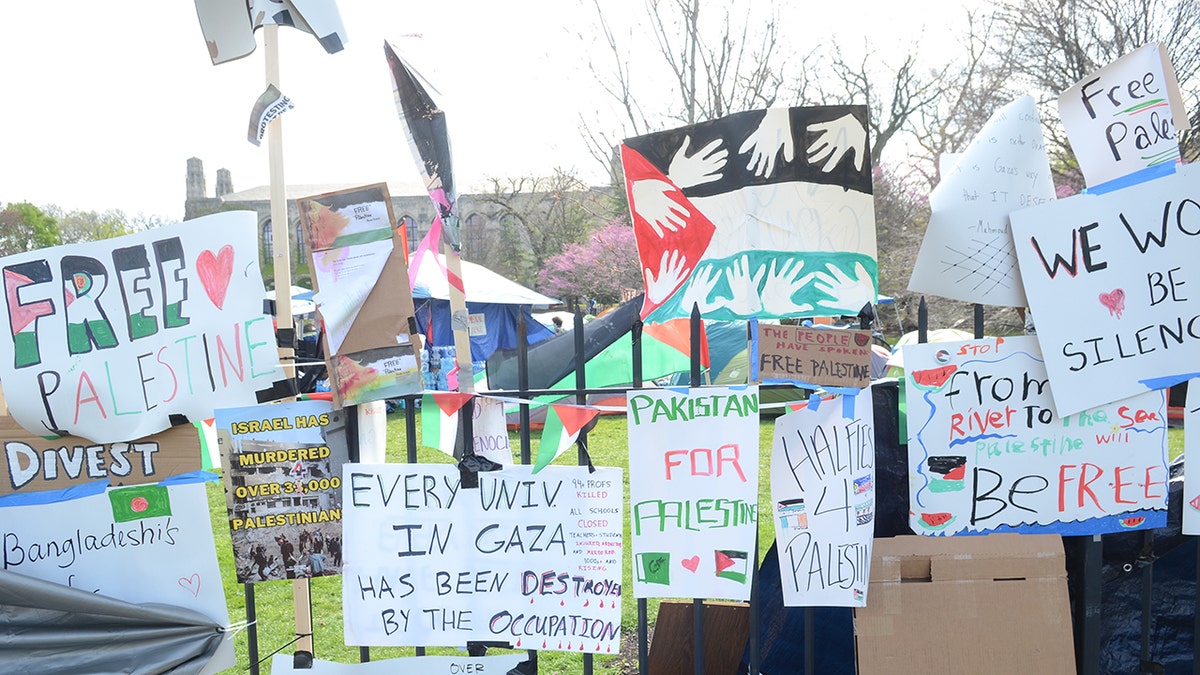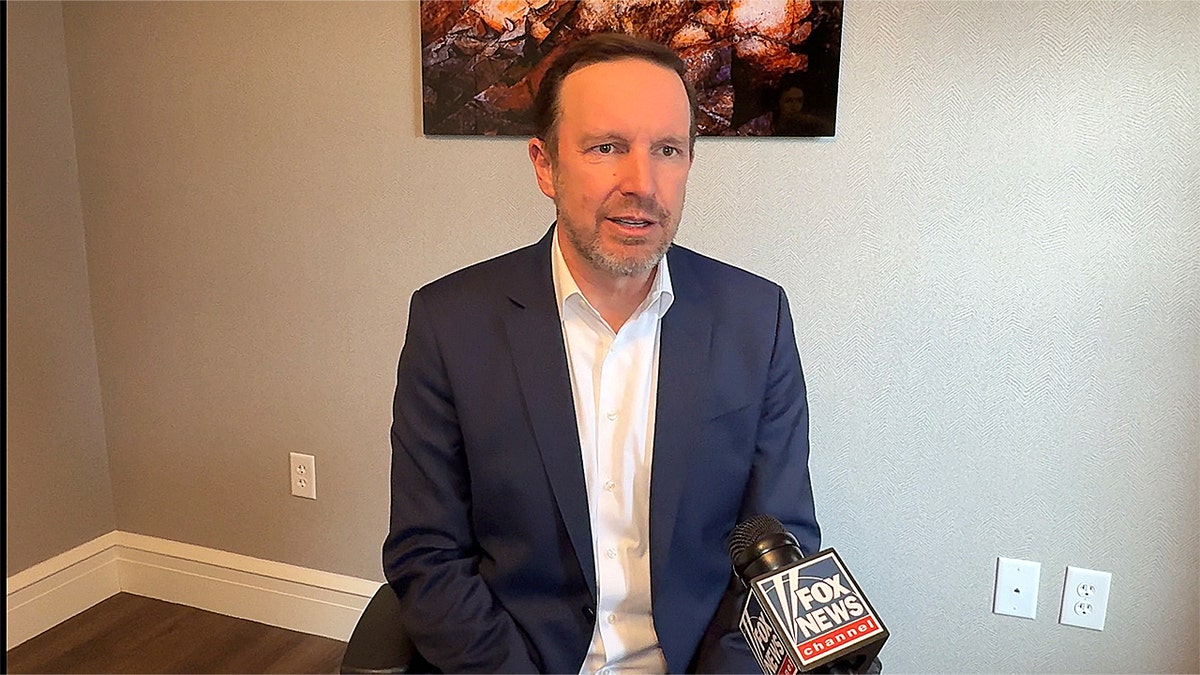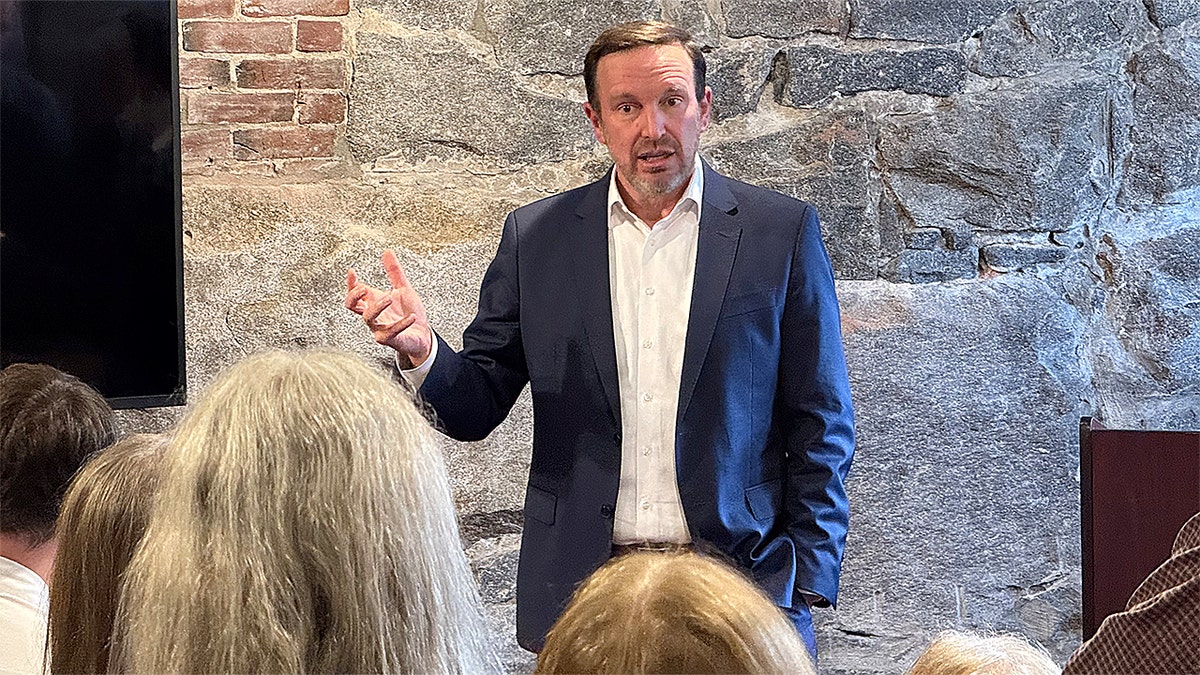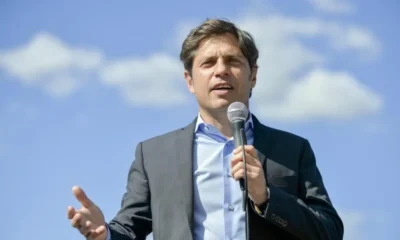INTERNACIONAL
Antisemitism spiking around the world, ADL task force finds in its 1st-ever global report

The Anti-Defamation League (ADL) has released its first-ever J7 Annual Report on Antisemitism as the world prepares to mark the 80th anniversary of Victory in Europe (VE) Day.
The report details the rise in antisemitism seen in countries that have the largest Jewish populations outside Israel, including the U.S., the U.K., Argentina, Canada, France, Germany and Australia.
The J7 Task Force was founded in July 2023, just months before Hamas launched its deadly attacks on Israel. In the wake of the massacre, the ADL has noted an uptick in antisemitic incidents and sentiments around the world.
Anti-Israel demonstrators deface property on the day of Israeli Prime Minister Benjamin Netanyahu’s address to a joint meeting of Congress on Capitol Hill in Washington, D.C., on July 24, 2024. (Katie Pavlich)
ANTISEMITIC INCIDENTS BREAK RECORD FOR 4TH STRAIGHT YEAR, ADL FINDS
From 2021 to 2023, antisemitic incidents increased by 11% in Australia, 23% in Argentina, 75% in Germany, 82% in the U.K., 83% in Canada, 185% in France and 227% in the U.S., according to the ADL’s report. Additionally, the organization noted a «troubling» pattern in antisemitic incidents per Jewish capita in the J7 countries, including more than 38 incidents per 1,000 Jewish residents in Germany in 2023. Additionally, in Australia, incidents per Jewish capita quadrupled from 2023 to 2024.
The J7 Task Force report reveals common themes across all nations, such as increases in violent attacks, spikes in antisemitic rhetoric online and growing feelings of fear and insecurity among Jews.
In the report, the rising antisemitism in each of the J7 countries was documented by the Jewish communities directly impacted.
Argentina
The Delegación de Asociaciones Israelitas Argentinas (DAIA) found that antisemitism had become deeply embedded in social media and academic institutions. Argentinian Jewish students are reportedly choosing schools «based on whether or not they will be a target of antisemitic incidents, both from their fellow students and from their professors,» according to DAIA. The organization recommends more «work and engagement» in combatting antisemitism in academia.
In 2023, Argentina saw a 44% increase in antisemitic incidents compared to 2022. Like many other countries included in the report, the country saw a rise in antisemitism and anti-Zionism following Hamas’ Oct. 7 attacks.
Additionally, DAIA noted that Argentinian President Javier Milei’s strong support of Israel and the U.S. has led to «an increase in antisemitic and other conspiratorial rhetoric.»
DAIA also found some bright spots in Argentina, noting that 60% of Argentinians, especially those aged 25-34, have a favorable view of Israel and just 7% favor boycotting Israeli products and businesses. This could be because Argentina has felt the impact of a terrorist organization that has also attacked Israel. Hezbollah carried out two deadly bombing attacks in Buenos Aires, one in 1992 at the Israeli Embassy and another in 1994 at the AMIA-DAIA Jewish Center.

«Free Palestine» graffiti is seen on a fence praising the Oct. 7 Hamas massacre against Israelis. (Executive Council of Australian Jewry )
AUSTRALIA’S JEWISH COMMUNITY ALARMED BY RISING ANTISEMITISM
Australia
The Executive Council of Australian Jewry’s (ECAJ) report, which covers Oct. 1, 2023-Sept. 30, 2024, showed a sizable 316% increase in antisemitic incidents. In the 12-month period the ECAJ studied, it found 2,062 antisemitic incidents compared to 495 incidents in the previous year. In the decade prior, the number of antisemitic incidents each year ranged from 190 to 495.
ECAJ cited Dr. Adina Bankier-Karp and Dr. David Graham’s survey, «Australian Jews in the Shadow of War,» which found that 64% of Australian Jews felt that antisemitism was «very much» a big problem in the country. This, according to the report, is 10 times higher than the response in 2017.
The Australian federal government in 2024, as well as many state governments, banned hate symbols such as swastikas and the Nazi salute. Symbols of terrorist organizations were also banned. However, ECAJ said it does not believe these laws do enough to combat «post-Oct. 7 sources of antisemitism.»
«While these laws are welcomed, they are not addressing the post-October 7 sources of antisemitism in Australia which makes up the majority of incidents, nor will the laws counter anti-Jewish attitudes and incidents,» ECAJ wrote in the report.
Canada
The report on Canada was compiled by the Centre for Israel and Jewish Affairs (CIJA). The organization said Canada’s main challenges include increased threats of violence and «anti- Israel actions taken by the federal government that display a double standard towards the Jewish state, such as the imposition of an arms embargo.»
While the data for 2024 is not yet available, CIJA noted that the 2023 statistics show «disturbing trends.» While Jews make up just 1% of the country’s population, 19% of reported hate crimes were motivated by antisemitism. Additionally, hate crimes against Jews increased by 71% from 2022 to 2023, according to CIJA.
In the report, CIJA called out the Canadian government’s «inaction» on antisemitism. The organization called for action and legal reform to help fight rising antisemitism.
Nearly all Canadian Jews, 98%, said antisemitism is a «serious or somewhat serious problem,» according to CIJA. Additionally, 82% said «Canada has become less safe for Jews» since Hamas’ Oct. 7 massacre.

Students and residents camp outside Northwestern University during an anti-Israel protest, expressing solidarity with Palestinians with banners in Evanston, Illinois, on April 27. (Jacek Boczarski/Anadolu via Getty Images)
France
Conseil Représentatif des Institutions Juives de France (CRIF) found clear links between antisemitic incidents and the ongoing Israel-Hamas war. According to CRIF, more than 30% of antisemitic incidents in 2024 included references to «Palestine.» French schools also saw antisemitic incidents more than quadruple, reaching 1,670 in the 2023-2024 academic year, compared to 400 the year before.
CRIF found that antisemitic incidents became more violent in 2024. These incidents included the rape and assault of a 12-year-old Jewish girl because of her «bad words on Palestine» and the arson and antisemitic graffiti at the Rouen synagogue.
The organization said it welcomed the French government’s adoption of a national plan to fight racism, antisemitism and discrimination. The plan was adopted in 2023 and is set to be implemented through 2026.
CRIF said in its report that many French Jews have stopped displaying or speaking about their religious identity out of fear. Even children steer clear of the topic to avoid harassment in school.
GLOBAL RISE IN ANTISEMITISM LEAVES JEWISH COMMUNITY ISOLATED, RABBI SAYS WORLD AT ‘A TIPPING POINT’
Germany
Zentralrat der Juden in Deutschland (ZJD) sounded the alarm over rising antisemitism, pointing out that «October 7, 2023, has massively accelerated a development that was already looming.» Antisemitism in Germany is not unique to one side of the political aisle, though ZJD points out the rise of Alternative für Deutschland (AfD) «poses a major challenge.»
AfD holds multiple positions that, if turned into reality, would make life extremely difficult for observant German Jews, including the banning of religious slaughter of animals, which could effectively make kosher meat illegal.
German police found 3,200 crimes from Jan. 1, 2024, to Oct. 7, 2024, were motivated by antisemitism. This comes after the Office on Research and Information on Antisemitism in Hessen found 3,000 antisemitic incidents between Oct. 7, 2023, and the end of that same year.
A January 2025 study by the Claims Conference found that approximately 40% of 18- to 29-year-olds in Germany did not know that more than 6,000,000 Jews were murdered in the Holocaust. However, the ADL’s 2024 Global 100 survey shows Holocaust distortion and denial is lower in Germany compared to other Western European nations.
ZJD concluded that ongoing debates in Germany surrounding social issues have direct impacts on the Jewish community.

Antisemitic hate on display at an anti-Israel protest in London. Antisemitism in the U.K. is hitting record levels since the Hamas terror attacks on Oct. 7. (Campaign Against Antisemitism on X)
ADL ALLEGES WIKIPEDIA EDITORS ENGAGING IN ‘COORDINATED CAMPAIGN’ AGAINST ISRAEL
The United Kingdom
The Board of Deputies of British Jews (the Board) said in its section of the report that antisemitism has dropped since Q4 2023 but still remains above pre-Oct. 7 levels. Meanwhile, British Jews are «finding everyday life in the U.K. an increasing challenge» with 25% of British Jews feeling unsafe in the country.
The Community Security Trust’s 2024 Antisemitic Incidents Report showed 3,528 antisemitic incidents in the U.K., representing an 18% decrease from the 4,296 incidents reported in 2023.
«Posters of Israeli hostages are regularly torn down, and in major cities the UK has faced weekly hate marches calling for Israel’s destruction,» the Board wrote. It also stated that the Institute of Jewish Policy Research called this phenomenon «ambient antisemitism.»
The Board acknowledged the government’s actions to fight antisemitism but said that statistics showed that further action was needed. «Enhanced law enforcement, stricter regulations on online hate speech, and comprehensive educational programs are essential to effectively combat antisemitic attitudes and behaviors,» the Board wrote.
Overall, the Board believes the U.K.’s three main areas of focus should be addressing antisemitic incidents, fighting online hate speech and restoring a sense of security among British Jews.
CLICK HERE TO GET THE FOX NEWS APP
The United States
The ADL and the Conference of Presidents of Major American Jewish Organizations worked together to compile a report on rising antisemitism in the U.S., noting the «alarming rise» in antisemitic incidents and attitudes.
In its 2024 antisemitism audit, which was released last month, the ADL identified 9,354 antisemitic incidents in 2024, a 5% increase from 2023 and a staggering 926% increase since it began tracking in 1979.
«Let’s be clear, antisemitism is an irrational hatred of individuals or institutions just because they are Jewish,» ADL CEO Jonathan Greenblatt told Fox News Digital upon the release of the audit. He also noted that «ADL has been conducting an annual audit of antisemitic incidents since the 1970s. And we’ve simply never seen numbers like this.»
The ADL and the Conference of Presidents of Major American Jewish Organizations found that «the groundswell of antisemitism in the United States shows no signs of abating.» In the report, both organizations said that the polarized political environment makes it hard to predict how antisemitism will develop.
INTERNACIONAL
Emoción y un profundo silencio: Francia conmemora con el corazón apretado los 10 años de los brutales atentados en París

En el Stade de France
La peregrinación de los cafés y terrazas
El Bataclan renacido
La gran ceremonia de la noche
INTERNACIONAL
Democratic senator calls for ‘more effective leadership’ as Schumer faces mounting pressure

NEWYou can now listen to Fox News articles!
CONCORD, N.H. — Amid heated calls by some House Democrats and others in the party to remove Sen. Chuck Schumer from his longtime role as Senate Democratic leader, a top Democrat in the chamber is calling for «more effective leadership.»
Sen. Chris Murphy of Connecticut told Fox News Digital that Schumer needs to lead a conversation to «stop having a group of members cross over and support Donald Trump’s agenda.»
Murphy was interviewed on Wednesday, two days after seven Senate Democrats and independent Sen. Angus King of Maine, who caucuses with the party, bucked Senate Democratic leaders and voted with the majority Republicans to end the longest federal government shutdown in history.
Plenty of progressives and center-left Democrats have pilloried the deal to end the shutdown, which didn’t include the Democrats’ top priority, an agreement to extend expiring subsidies that make health insurance coverage through the Affordable Care Act, known as the ACA or Obamacare, more affordable to millions of Americans.
SCHUMER FACES FURY FROM THE LEFT OVER DEAL TO END SHUTDOWN
Senate Minority Leader Charles Schumer, D-N.Y., after a news conference in the U.S. Capitol on the government shutdown on Nov. 5, 2025. (Tom Williams/Getty)
And even though he opposed the agreement, Schumer, the top Democrat in the chamber, has faced calls from some House Democrats and others in the party to step down due to his inability to keep Senate Democrats unified.
But to date, no Senate Democrat has joined those calls for Schumer to step down.
Asked if Schumer was still up to the task of steering Senate Democrats, Murphy said, «I think his job is really, really hard. He obviously did not want this outcome. He wanted the caucus to stay together. He was not successful in that endeavor.»
TRUMP ARGUES SCHUMER MADE A MISTAKE
«We’ve got to have a hard conversation as a caucus about what we all need to do, what kind of leadership we need in order to make sure that we don’t continue to break apart,» added Murphy, who as Deputy Democratic Conference Secretary is a member of the party’s leadership in the chamber.
And he noted that «this is the fourth major moment this year where a handful of Democrats have crossed over and voted with Donald Trump.»
«That means we need more effective leadership. That also means that the caucus has to decide for itself that we’re not going to continue to break apart like this,» he emphasized.

Sen. Chris Murphy sits for a Fox News Digital interview on Nov. 12, 2025, in Concord, New Hampshire. (Paul Steinhauser/Fox News)
Murphy said Senate Democrats «have to make a decision as a caucus to stop breaking apart like this.» And pointing to Schumer, he added, «That’s a conversation that, yes, the leader of the caucus has to head up, but it’s a conversation all of us have to have. We all have to hold each other accountable.»
Murphy was interviewed after headlining an event in New Hampshire’s capital city with the Merrimack County Democrats. New Hampshire’s two senators — Jeanne Shaheen and Maggie Hassan — were among the Democrats who supported the deal with Republicans.
SHUTDOWN SHOWDOWN: DEMOCRATIC SENATOR STANDS FIRM AFTER DEFYING PARTY
Shaheen, who previously supported a bill to extend the ACA subsidies, on Monday defended breaking with her party to support the deal.
«We’re making sure that the people of America can get the food benefits that they need, that air traffic controllers can get paid, that federal workers are able to come back, the ones who were let go, that they get paid, that contractors get paid, that aviation moves forward,» Shaheen said in a «Fox and Friends» interview.
Asked about Shaheen’s comments, Murphy said Senate Democrats «had a big disagreement.»
«I understand why my colleagues wanted to end the shutdown. I wanted to end this shutdown. The fact is that shutdowns hurt and Trump was making the shutdown even worse than it had to be by, for instance, illegally denying people food stamp benefits, nutrition benefits,» Murphy argued.
But he added, «I still think we could have won. I think as these premium increases were just becoming real for people, as folks are digesting an election that clearly was a referendum on the way that Donald Trump was plunging the country to shut down, we could have actually gotten a resolution that would have stopped at least some of the pain that’s coming to families as these healthcare premiums go into effect.»
The deal to end the shutdown does not include such a provision, but only a promise by the majority Republicans to hold an upcoming vote on extending the subsidies.
And Murphy lamented that the deal will only embolden the president.
«I definitely worry that when Trump gets the opposition party to yield to him, as he did last week, that it just emboldens him, that he ends up acting even more lawlessly and recklessly and illegally,» he said. «I understand why my colleagues wanted to end this shutdown. I am just of the belief that Trump is going to constantly try to weaponize our compassion against us.»

Sen. Chris Murphy speaks to a gathering of Merrimack County Democrats on Nov. 12, 2025, in Concord, New Hampshire. (Paul Steinhauser/Fox News)
Murphy, who during former President Joe Biden’s tenure in the White House spent much of his time trying to reach across the aisle to find common ground with Republicans on such issues as gun control, immigration and Ukraine, is now helping fund organizations that are pushing back against Trump and his agenda.
«I’ve been making grants to protest organizations and grassroots organizations all around the country,» he said.
And the senator, who won re-election last year in blue-leaning Connecticut by nearly 20 points, highlighted that «I’ve been all over the country this year. I’ve been holding town halls, often with other colleagues, targeting mostly states that are represented by Republicans, so that they’re hearing the other side.»
And looking ahead to next year’s midterm elections, he said, «I’ll likely be traveling throughout New England, but also throughout the rest of the country, to try to help stand up a national mobilization against Trump’s corruption.»
Murphy is seen by political pundits as a possible contender for the 2028 Democratic presidential nomination, which is expected to be a crowded and competitive race.
After his interview with Fox News Digital, Murphy headlined the latest «Stand Up New Hampshire Town Hall.» The speaking series, organized by top New Hampshire Democratic elected officials and party leaders, is seen as an early cattle call for potential White House contenders.
The New Hampshire Republican Party welcomed Murphy to the first-in-the-nation presidential primary state with an email released titled «NHGOP Welcomes Future Failed Presidential Candidate Chris Murphy to New Hampshire.»
Asked about a possible presidential run in 2028, Murphy said, «I think it’d be so foolish for any of us to be thinking about running in an election in 2028 that may not happen. I mean, I think this moment is really serious. I think Donald Trump is trying to rig the rules of American democracy so that either he can run again or that the opposition party has no chance to win.»
CLICK HERE TO DOWNLOAD THE FOX NEWS APP
Pointing to his current mission «to help save our democracy,» Murphy insisted «that’s all I’m focused on right now. And I think that is what I would recommend to all of my colleagues, whether they’re thinking about running for national office in 2028 or whether they have no plans to do so.»
«We have one mission right now, which is to make sure there actually is an election in 2028 where a Democrat has a reasonable chance of winning,» he added.
chuck schumer,democrats senate,democratic party,donald trump,government shutdown,midterm elections,new hampshire,presidential primaries
INTERNACIONAL
La mega cárcel a la que fue trasladado Jorge Glas tiene un avance de construcción del 30 por ciento

Daniel Noboa reconoció públicamente que la llamada “Cárcel del Encuentro”, el nuevo penal de máxima seguridad al que fue trasladado el ex vicepresidente Jorge Glas y varios cabecillas del crimen organizado, aún no está terminada. En una entrevista radial, el presidente detalló que el complejo carcelario está “entre el 35% y el 40%” de avance, pero defendió la decisión de adelantar el traslado de los reclusos más peligrosos por razones de seguridad y prometió que la obra se completará en las próximas semanas.
En diálogo con Radio Sucre, Noboa respondió a las críticas sobre el envío de presos a una cárcel cuya construcción sigue en marcha. “La cárcel no está al 100%, no está al 100%, pero ya está al 35–40%. En dos semanas estará al 80% y se finalizará el último pabellón y las últimas cosas en un mes”, aseguró. Con esa descripción, el mandatario trazó por primera vez un cronograma público de la obra, que el Gobierno ha presentado como emblema de su ofensiva contra el narcotráfico y las bandas criminales.
El anuncio llega después del traslado de Jorge Glas y de otros presos de alto perfil al nuevo penal, lo que encendió el debate sobre las condiciones de la infraestructura y la legalidad de las decisiones penitenciarias. Mientras organizaciones y voces críticas cuestionan que se use un centro “en obra gris” para alojar a personas privadas de libertad, el Gobierno sostiene que la prioridad es neutralizar la capacidad de mando de los líderes criminales desde las cárceles tradicionales. Noboa reiteró que los primeros en ser trasladados fueron “los más malos, los que ya desde la cárcel se pasaban organizando asesinatos y secuestros”.

El presidente vinculó directamente la premura por habilitar la Cárcel del Encuentro con el clima político previo al referéndum y consulta popular del 16 de noviembre. Según su versión, grupos delictivos estarían buscando desestabilizar al país ante la posibilidad de una victoria del “sí” en las preguntas impulsadas por el Ejecutivo. “Era urgente viendo lo alterados que están, porque está ganando el sí y quieren hacer relajo y quieren matar la mayor cantidad de gente para decir que este gobierno fracasa”, afirmó. No presentó pruebas concretas durante la entrevista, pero insistió en que la lectura de inteligencia del Gobierno justificaba adelantar el uso parcial del complejo penitenciario.
Más allá de esa coyuntura, Noboa enmarcó la Cárcel del Encuentro en un rediseño más amplio del sistema penitenciario. El mandatario sostuvo que no se trata de una obra aislada, sino del primer paso de un plan que incluye la construcción de otro gran centro carcelario de mediana seguridad, también en la Costa, con capacidad para unas 15.000 personas privadas de libertad. “Se va a construir otra cerca, grande, no de máxima seguridad, sino de mediana seguridad, para aproximadamente 15.000 personas”, adelantó. Según su diagnóstico, en el sistema actual hay entre 6.000 y 7.000 presos en hacinamiento y varias cárceles que “nunca se arreglaron” y hoy son inseguras tanto para los funcionarios como para los internos.
Noboa describió problemas estructurales en las prisiones tradicionales: puertas e infraestructura que no funcionan, flujos internos que no permiten reaccionar ante emergencias y pabellones donde el Estado ha perdido el control frente a las bandas. Argumentó que el nuevo complejo y la futura cárcel de mediana seguridad buscan justamente revertir ese escenario, concentrando a los internos de mayor peligrosidad en espacios controlados y tecnológicamente monitoreados, y reordenando el resto de la población penitenciaria.

La Cárcel del Encuentro se ha convertido en un símbolo del enfoque de Noboa en seguridad: una mezcla de infraestructura penitenciaria de alta seguridad, discurso de mano dura y comunicación directa en redes sociales. Días antes, el presidente difundió en X (antes Twitter) una imagen en la que aparecían Glas y otros procesados y condenados por delitos graves, acompañada de un mensaje en el que advertía que “pronto llegarán otros criminales” al nuevo penal. El gesto fue leído por sus críticos como una utilización política de los expedientes judiciales, al calor de la campaña por el referéndum.
En la entrevista radial, el mandatario buscó presentar la cárcel no solo como un símbolo, sino como una respuesta funcional a la violencia que ha sacudido al país en los últimos años. Su narrativa conecta la construcción acelerada del penal con otros elementos de política pública, como los decretos de estado de excepción, las operaciones contra la minería ilegal y la cooperación internacional en seguridad. A la vez, insiste en que la actual Constitución —que él pretende reformar a través de una Asamblea Constituyente si triunfa el “sí”— “beneficia a los criminales” y limita la acción de las fuerzas del orden.

 CHIMENTOS2 días ago
CHIMENTOS2 días agoWada Nara se despidió de sus hijas con un desgarrador mensaje al entregárselas a Mauro Icardi: «Que la pasen hermoso»

 POLITICA2 días ago
POLITICA2 días agoAxel Kicillof prometió no subir impuestos, pero montó un mecanismo de recaudación con Ingresos Brutos

 ECONOMIA1 día ago
ECONOMIA1 día agoGuiño al crédito fintech: el BCRA autorizará el débito directo de cuotas, prohibido durante el Gobierno anterior


















